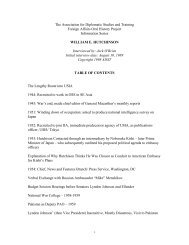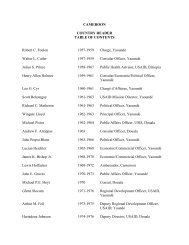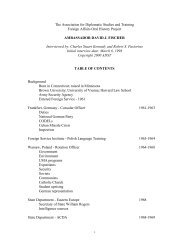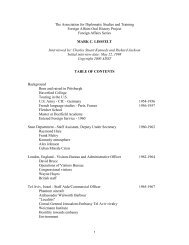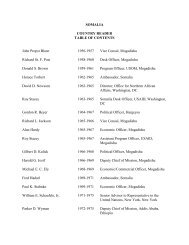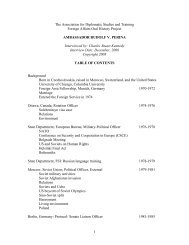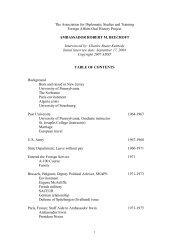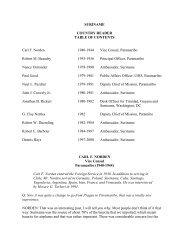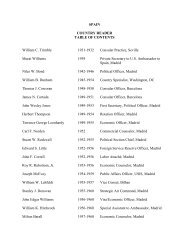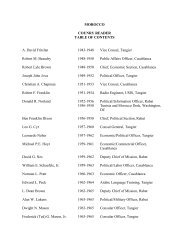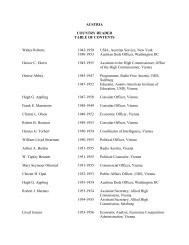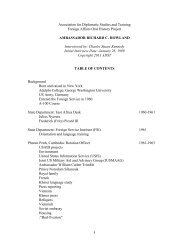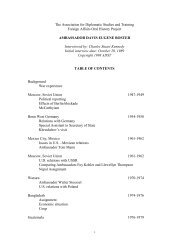1 The Association for Diplomatic Studies and Training Foreign ...
1 The Association for Diplomatic Studies and Training Foreign ...
1 The Association for Diplomatic Studies and Training Foreign ...
You also want an ePaper? Increase the reach of your titles
YUMPU automatically turns print PDFs into web optimized ePapers that Google loves.
Q: Well, now let’s talk about the consulate, not consulate-general …<br />
MILLER: <strong>The</strong>re were five consulates.<br />
Q: … in Isfahan, at that time, because our reporting out of Iran has been very, has been<br />
criticized, that sometimes were too much this way or that way, you know. When you<br />
arrived what was sort of the attitude <strong>and</strong> what was the task of the consulate?<br />
MILLER: <strong>The</strong> consulate was really a kind of a – the consul was a pro-consul, in many<br />
ways, because there was a huge economic <strong>and</strong> military assistance ef<strong>for</strong>t, Point Four <strong>and</strong><br />
ARMISH-MAAG ef<strong>for</strong>t underway.<br />
Q: Begun in the Truman administration.<br />
MILLER: Yes, it was. Point Four was the <strong>for</strong>erunner to USAID (U.S. Agency <strong>for</strong><br />
International Development). <strong>The</strong> Point Four Plan, of course was, developed in the time of<br />
Truman, <strong>for</strong> assistance to Greece, Turkey, <strong>and</strong> Iran – Egypt, as an emergency <strong>for</strong>eign<br />
policy <strong>and</strong> security tool. That took the <strong>for</strong>m of technical assistance, largely in agriculture,<br />
health, <strong>and</strong> water projects, airports, infrastructure, <strong>and</strong> there were quite a few aid<br />
technicians who gave, in many cases, extremely effective help, particularly the doctors in<br />
the universities <strong>and</strong> hospitals. <strong>The</strong> development assistance of Point Four was extremely<br />
helpful to Iran.<br />
<strong>The</strong>n we also had a very large ARMISH-MAAG (US Army Mission Military Assistance<br />
Advisory Group) contingent. ARMISH-MAAG was the military, the military security<br />
assistance. It was under the comm<strong>and</strong> of a general who wanted to assist a military<br />
academy in Isfahan, particularly giving access to artillery <strong>and</strong> tanks. We had a large<br />
military training component, a feature that lasted until the revolution in 1979. At the end,<br />
in 1979 they had air <strong>for</strong>ce training in Isfahan, <strong>and</strong> of course Bell Helicopters was building<br />
helicopters in Isfahan, <strong>and</strong> communications factories.<br />
<strong>The</strong>n there were training <strong>and</strong> technical programs in all of the structures – the police, the<br />
gendarmerie, doctors’ education. So the consulate was in <strong>for</strong>mal charge of all of this. As<br />
vice-consul I was in charge of all of this when Frank Craw<strong>for</strong>d was on leave.<br />
Q: <strong>The</strong>re were just two of you?<br />
MILLER: <strong>The</strong>re were two <strong>Foreign</strong> Service officers.<br />
Q: And the CIA.<br />
MILLER: <strong>The</strong> CIA station chief, the USIS officer, later Bill Meader <strong>and</strong> the Point Four<br />
head, Harvey Coverley <strong>and</strong> John Hollligsworth, our administrative assistant <strong>and</strong> code<br />
clerk.<br />
33




